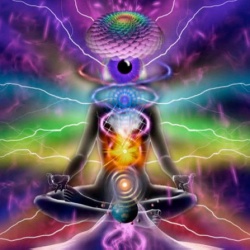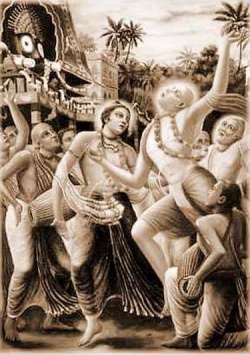The Three Realms
Buddhist cosmology mentions three realms (or reigns, or worlds, or spheres) of existence, each one referring to a specific kind of rebirth connected with the fruits of the attainment of a meditative state (pali: jhāna, sanscrit: dhyāna).
The picture of the world presented in Buddhist cosmology cannot be taken as a literal description of the shape of the universe from an ordinary point of view. Rather, it is the universe as seen through the eyes of a Buddha, since an enlightened being can perceive all of the other worlds and the beings born, risen up and passing away within them.
DESIRE REALM (kāmadhātu)
The beings born in the Kāmadhātu differ in degree of happiness, but they are all, other than arhats and Buddhas, under the domination of Māra and are bound by sensual desire, which causes them suffering. Within the desire world are either five or six realms of existence representing different kind of suffering (in Theravada tradition for example there are only five realms, because the domain of the asuras is not regarded as separate from that of the devas).
FORM REALM (rupadhātu)
It’s the first of the physical realms though the bodies of its inhabitants are composed of a subtle substance which is invisible to the inhabitants of the Kāmadhātu. The dwellers in the form realms have minds corresponding to the four lower meditative states (rupadhyānas). There are five form realms, the first four corresponding to the four types of rupadhyānas:
BRAHMĀ WORLDS The mental state of the devas of the Brahmā worlds corresponds to the first meditative state, and is characterized by observation and reflection as well as delight and joy. The Buddha said about this state: “Quiet secluded from sensuality, secluded from unskillful mental quality, he enters and remains in the first jhana (pali for dhyāna, the meditative state): rapture and pleasure born of seclusion, accompanied by directed thought and evaluation”.
ĀBHĀSVARA WORLDS The mental state of the devas of the Ābhāsvara worlds corresponds to the second meditative state, and is characterized by delight as well as joy. These devas are said to have bodies that emit flashing rays of light like lightning. The Buddha described this state as “rapture and pleasure born of concentration, unification of awareness free from directed thought and evaluation, internal assurance.”
ŚUBHAKṚTSNA WORLDS The mental state of the devas of the Śubhakṛtsna worlds corresponds to the third meditative state, and is characterized by a quiet joy. These devas have bodies that radiate a steady light. About the spiritual practitioner who entrers this meditative state the Buddha said: “Then with the fading of rapture, he remains equanimous, mindful, and alert, and senses pleasure with the body. Equanimous and mindful, he has a pleasant abiding.”
BṚHATPHALA WORLDS The mental state of the devas of the Bṛhatphala worlds corresponds to the fourth meditative state, and is characterized by equanimity. About the spiritual practitioner who entrers this meditative state the Buddha said: “Then with the abandoning of pleasure and pain, he enters and remains in purity of equanimity and mindfulness, neither pleasure nor pain. He sits permeating the body with a pure, bright awareness.”
ŚUDDHĀVĀSA WORLDS This world are said the “Pure Abodes” and they are distinct from the other worlds of the form because in Śuddhāvāsa don’t live devas who have been born there through ordinary merit or meditative attainments, but only those Non-returners (Anāgāmins) who are already on the path to Arhat-hood (the state of a spiritual practitioner who has realized certain high stages of attainment) and who will attain enlightenment directly from the Śuddhāvāsa worlds without being reborn in a lower plane (even if Anāgāmins can also be born on lower planes). Every Śuddhāvāsa deva is therefore a protector of Buddhism. No Bodhisattva is ever born in these worlds, because a Bodhisattva must ultimately be reborn as a human being.
FORMLESS REALM (Ārūpyadhātu)
The formless realm would have no place in a purely physical cosmology, as none of the beings inhabiting it has either shape or location. In this realm live those devas who attained one of the four Formless Absorptions of the ārūpadhyana (the four higher meditative states) in a previous life, and now enjoys the fruits of the good karma of that accomplishment. Bodhisattvas are never born in the Ārūpyadhātu even when they have attained the arūpadhyānas. There are four types of Ārūpyadhātu devas, corresponding to the four types of arūpadhyānas:
ĀKĀŚĀNANTYĀYATANA This world is also said the ”Sphere of Infinite Space”. In this sphere formless beings dwell meditating upon space or extension as infinitely pervasive.
VIJÑĀNĀNANTYĀYATANA This world is also said the ”Sphere of Infinite Consciousness”. In this sphere formless beings dwell meditating on their consciousness as infinitely pervasive.
ĀKIṂCANYĀYATANA This world is also said the ”Sphere of Nothingness” (literally “lacking anything”). In this sphere formless beings dwell meditating upon the thought that “there is no thing“. This is considered a form of perception (samjñā), though a very subtle one.
NAIVASAṂJÑĀNĀSAṂJÑĀYATANA This world is also said the ”Sphere of Neither Perception nor Non-Perception”. In this sphere the formless beings have gone beyond a mere negation of perception and have attained a state where they do not engage in perception (samjñā) but are not wholly unconscious.


